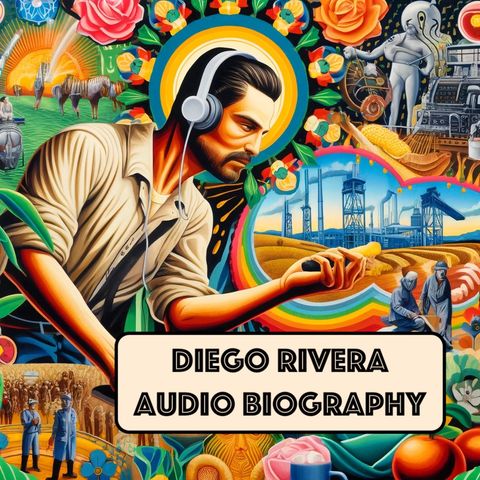Diego Rivera Biography

Download and listen anywhere
Download your favorite episodes and enjoy them, wherever you are! Sign up or log in now to access offline listening.
Diego Rivera Biography
This is an automatically generated transcript. Please note that complete accuracy is not guaranteed.
Description
Diego María de la Concepción Juan Nepomuceno Estanislao de la Rivera y Barrientos Acosta y Rodríguez (yes, that's his full name) was born on December 8, 1886, in Guanajuato, Mexico....
show moreAt the tender age of 10, Rivera began studying art at the prestigious San Carlos Academy of Fine Arts in Mexico City. But it wasn't long before he outgrew his hometown and set his sights on Europe. In 1907, at the age of 20, Rivera moved to Spain to continue his studies, thanks to a generous scholarship from the governor of Veracruz.
In Europe, Rivera was exposed to the cutting-edge art movements of the time, from Impressionism to Cubism. He hobnobbed with the likes of Pablo Picasso and Amedeo Modigliani, soaking up their ideas and techniques like a sponge.
For a while, Rivera was all about Cubism. He experimented with breaking down forms into geometric shapes and planes, creating paintings that looked like something out of a fever dream. But eventually, he grew tired of the intellectual games and yearned for something more meaningful.
In the 1920s, Rivera returned to Mexico and joined the muralist movement, a group of artists who believed that art should be accessible to everyone, not just the elite. They painted massive murals on public buildings, telling the stories of Mexico's history and people in bold, vivid colors.
Rivera quickly became the star of the movement, with his murals gracing the walls of government buildings, schools, and museums across Mexico. His style was a unique blend of European modernism and Mexican folk art, with a heavy dose of political commentary thrown in for good measure.
In 1933, Rivera was commissioned to paint a mural in the lobby of the Rockefeller Center in New York City. The mural, titled "Man at the Crossroads," was supposed to depict the progress of human civilization. But Rivera, being Rivera, couldn't resist throwing in a little political provocation.
In the mural, he included a portrait of Vladimir Lenin, the leader of the Russian Revolution, and a scene of a May Day parade. The Rockefellers, who were famously anti-communist, were not amused. They demanded that Rivera remove the offending elements, but he refused. The mural was destroyed, and Rivera was fired from the project.
No discussion of Diego Rivera would be complete without mentioning his tumultuous relationship with fellow artist Frida Kahlo. The two were married in 1929, when Rivera was 42 and Kahlo was just 22. To say their relationship was complicated would be an understatement.
They divorced in 1939, only to remarry in 1940. Throughout their marriage, both Rivera and Kahlo had numerous affairs, with both men and women. But despite the infidelities and the arguments, they remained deeply connected until Kahlo's death in 1954.
In the later years of his life, Rivera continued to paint and to court controversy. He was a vocal supporter of the Cuban Revolution and a friend of Fidel Castro, which didn't exactly endear him to the American government.
But Rivera was never one to back down from a fight. He continued to use his art as a weapon against injustice and oppression, even as his health began to fail. He died on November 24, 1957, at the age of 70.
Today, Diego Rivera is remembered as one of the greatest artists of the 20th century. His murals are still studied and admired around the world, and his influence can be seen in the work of countless contemporary artists.
But Rivera was more than just a painter. He was a revolutionary, a troublemaker, and a true original. He showed us that art could be a powerful force for social change, and that the artist had a responsibility to speak truth to power.
For a communist rabble-rouser, Diego Rivera has had a surprisingly robust presence in popular culture. He's been portrayed in movies, TV shows, and even video games. His relationship with Frida Kahlo has been the subject of countless books, plays, and films, including the 2002 biopic "Frida."
But perhaps the most enduring legacy of Diego Rivera is the way his art continues to inspire and provoke us to this day. Whether you love him or hate him, there's no denying the power and passion of his work.
So, what can we learn from the life and art of Diego Rivera? Well, for one thing, never be afraid to speak your mind, even if it means pissing off a few billionaires along the way.
But more importantly, Rivera teaches us that art is not just a pretty picture on a wall. It's a tool for change, a way of shining a light on the injustices and inequalities of the world. It's a way of giving voice to the voiceless and power to the powerless.
In a world that often seems divided and broken, Rivera reminds us of the transformative power of art to bring people together and to create a shared vision of a better future.
Information
| Author | QP-3 |
| Organization | William Corbin |
| Website | - |
| Tags |
Copyright 2024 - Spreaker Inc. an iHeartMedia Company

Comments